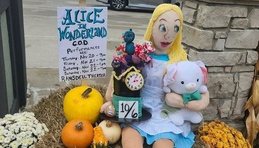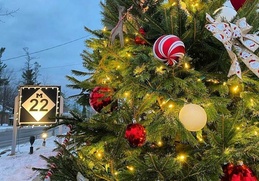
We Speak for the Trees
How Archangel Ancient Tree Archive is reforesting the planet
By Jillian Manning | April 23, 2022
The warehouse that Archangel Ancient Tree Archive (AATA) calls home is unassuming, a green and white affair nestled in the small village of Copemish in Manistee County. The town’s name means “big beech,” and in that sense, it’s a perfect place for a nonprofit like AATA, a nonprofit with a mission to fight climate change by rebuilding the old-growth forests of the world.
For the last 25 years, the organization has been cloning, growing, and planting the world’s oldest and biggest trees. Why? To preserve those invaluable genetics. These are the trees who have stood the test of time, who have survived all manner of challenges for centuries and kept getting older and bigger. They are evolutionary marvels, and the secret to restoring our forests with hearty, long-lasting trees could very well lie in their DNA.
Old-growth forests are at least 120 years old or have an average tree diameter greater than 10 inches. This category includes the redwoods and sequoias of the West Coast, but also the eastern white pines and sugar maples here in Michigan. Some of the trees AATA has worked with have been north of 5,000 years old, a staggering age that feels incomprehensible to we humans, who at most live 2 percent of that lifespan.
But AATA’s trees aren’t just old—they are often the National Champion Trees of the world, the largest and most impressive of their species. They’ve topped over 350 feet tall and more than 30 feet in diameter. (For scale, 350 feet is taller than if you stacked the Park Place Hotel in Traverse City three times, and a 30-foot diameter takes about 16 adults to circle with outstretched arms.)
AATA has built a living archival library of these National Champions, preserving the genetic history of 130 tree species that stretch back millennia. Standing in the warehouse among the clones of these mighty trees is like achieving 1 degree of separation from the rock stars—nay, the gods—of the arboreal world.
And after a quarter century of groundbreaking work, AATA is just getting started.
The Family Business
David Milarch, the founder of AATA—and a cofounder of Oryana—is something of a real-life Lorax (sans the giant orange mustache). Sap may even run in his blood, as David was the third in his family to take up a career as a shade-tree nurseryman on the Milarchs’ Copemish land, growing maples, birches, and oaks for cities like Chicago, Detroit, and Minneapolis.
An organization like AATA is quite the shift in the Manistee County narrative. The area was once a treasure trove of virgin white pine forest, nearly all of which was cut down to build those same cities the Milarch nursery grows trees for.
There’s a certain irony—or perhaps long-overdue balance—that the region now houses one of the most unique and powerful climate change disruptors in the world.
“If we can do it from Copemish, Michigan, with no money, no PhDs, it should be really encouraging for anybody else…whatever their dream might be,” David says.
While David’s journey to AATA began with a near-death experience—a story worth an article of its own, involving renal failure and literal archangels—he shares credit for the idea of cloning the Champion Trees of the world with his sons, Jared and Jake. During their school years in the ’90s, the boys had observed significant die-off among the trees on the Milarch farm, an issue that was traced back to mercury and dioxin pollution from coal-fired power plants.
“One day, we were out pruning our trees, and the boys were talking back and forth about when they took over the shade tree farm like I did for my dad,” David explains. “And my son Jake says, ‘Yeah, but we’re not going to grow trees that die like that. We don’t want to lose the money.’ And Jared said, ‘Hey, Dad, you know those great big trees? … Why don’t we clone those? Wouldn’t they do better? They’re so big and old.’”
As a family in the tree business, the Milarchs had already visited Champion Trees across northern Michigan—the dendrophile version of sightseeing. David went along with the spirit of the boys’ suggestion and, with their help, collected cuttings from several Champion Trees, including a green ash in Elk Rapids, a Norway maple in Empire, and a black willow on the former State Hospital grounds in Traverse City.
The cuttings were sent off to a commercial nursery in Oregon, though the folks there made no promises that clones could be made. At the time, it was considered folly at best and impossible at worst to replicate ancient trees, akin to asking a 100-year-old woman to have a baby.
The Start of Something Big
But lo and behold…it worked. A year later, the Milarchs got a call reporting that the ash buds had grown to become 9-foot trees an inch in diameter.
“They’d never seen growth like that ever,” David says. He was then asked for 250,000 more buds off that tree, and soon thereafter was featured on the December 1996 cover of American Nurseryman magazine for the success.
That was the beginning of the Champion Tree Project, which would one day become Archangel Ancient Tree Archive. The program expanded from cloning Champion Trees to reproducing other impressive old-growth giants and bringing people together across the world to replant dwindling forests. David’s sons have followed in his footsteps and are now both in director roles at AATA, Jared as executive director and Jake as director of propagation and education program director.
As the trees grew, so did the word of what the Milarchs were doing. More press came knocking—major outlets like the New York Times, BBC World News America, Forbes, The Washington Post, and CNN. About 10 years ago, NYT science writer Jim Robbins even wrote a book about David and his work titled The Man Who Planted Trees: A Story of Lost Groves, the Science of Trees, and a Plan to Save the Planet.
But from what we see at the Copemish warehouse, fame has not made a mark on AATA. The team there is friendly and laid back, dressed in T-shirts and sweatshirts for our tour of the 20,000+ trees in various stages of growth throughout the facility. David himself declines being photographed, saying the story is about the trees, not him.
The Future Propagators
As part of our visit, Northern Express gets to experience a condensed version of AATA’s “tree school” to learn about the process of cloning and growing these magnificent trees. The warehouse has examples of every step, from tiny clippings in cultures to seedling flats to 15-foot coastal redwoods.
We aren’t the only lucky souls who have been to tree school. Prior to the pandemic, students from all over northern Michigan—and all over the country—have participated, including young people studying at the Greenspire School and Interlochen Arts Academy. David tells us that tree school is soon going global with a virtual curriculum to be filmed and produced by Interlochen.
“The kids have this context of [the relationship between] trees and climate change,” says Mary Ellen Newport, director of the R.B. Annis Department of Math & Science Division at Interlochen. Newport is an instructor of ecology and advanced biology and has worked with AATA throughout her tenure. “A key feature of what David is doing is to talk about massive replanting,” she says. “Right now, we don’t have very good technology to take carbon out of the air, so trees are the best shot we have. … With my steady band of 50 or 60 kids, we can get a lot of trees planted in the spring.”
Often, when AATA is ready to do a major seedling planting, whether it’s in Michigan or California, they partner with a local school so kids can learn firsthand about reforestation. This year, Newport says, the students will be planting black willows cloned from the Champion Tree in Traverse City.
The Science of Trees
When asked which trees the rest of us northern Michiganders should be planting, David immediately points to the willows, which he calls the “queens of the waterways” for their ability to purify our rivers and bays. These days, there are even companies like Ecolotree of Iowa that install fields of poplars and willows to successfully clean up toxic waste sites.
Countless studies have shown that trees are quite literally the filters for the rest of us who call Earth home. David explains that a mature giant sequoia—which weighs about 1,200 tons—can store up to 500 tons of carbon, 40 percent of its weight. That’s the equivalent of taking more than 100 cars off the road for a whole year.
“If every human being on Earth—man, woman, and child—will plant two trees a year and make them live, in 20 years, we could reverse climate change back to the 1980 carbon levels,” David says. “If you’re five years old or 105, you could be a part of the solution. There is hope.”
Of course, two trees per person across the world is no small feat, but the need for reforesting has never been more urgent. Only about 2 percent of old-growth forests still exist in the U.S. as the trees that once covered billions of acres of our country have been cut for timber, attacked by increasingly-virulent insects and fungi, or killed off thanks to increasing environmental pressures like pollution, fire, drought, disease, and storms. This pattern is predicted to continue—or worsen—as time goes on and more threats arise.
As Jim Robbins writes in The Man Who Planted Trees, his book about David, “Planting trees, I myself thought for a long time, was a feel-good thing, a nice but feeble response to our litany of modern-day environmental problems.” Now having interviewed scientists and researched the impact of trees in combating climate change, Robbins believes that “planting trees may be the single most important ecotechnology that we have to put the broken pieces of our planet back together.”
The Reforesting Mission
Putting the planet back together is where AATA thrives. From that first success with a green ash tree from Elk Rapids, their real work began. Today, AATA is based around the core tenants to propagate, archive, and reforest. Seedlings have been planted in seven different countries—including Australia, the United Kingdom, and New Zealand—and David says that volunteers across the world have lent a hand (or a shovel) to further the mission.
One major success was planting the future generation of the world’s oldest tree—Methuselah, a bristlecone pine clocking in at over 5,000 years old—in Washington, D.C. and at Charles University in Prague, Einstein’s teaching alma mater. AATA has also cloned George Washington’s trees at Mount Vernon, a feat that garnered the organization 11 minutes of airtime on The Today Show.
Another particularly special project took place in the last few years. Prior to the 2020 wildfires, AATA had gone out to Sequoia Crest, a 500-acre grove in the Sierra Nevada Mountain range, to clone some of the biggest trees on earth. These giants are thousands of years old, 30 feet in diameter, and grow in excess of 300 feet tall. The cloning was successful, and it happened just in time. Two years ago, wildfires destroyed half of the grove, including the Waterfall Sequoia, one of the largest trees on the planet. This past October, AATA returned to Sequoia Crest, and, with the help of a group of California school children, planted 150 seedlings where the parent trees had fallen.
And yet, despite the many achievements of AATA, the path has been riddled with nearly as many challenges. In David’s early days, his theories about cloning old-growth trees were derided by scientists, politicians, and even rival environmental organizations. Getting press about AATA is rarely a problem, but David says even though the stories about AATA have reached roughly two and a half billion people, news of their work often only motivates awareness, not real change or monetary support. In fact, he says AATA is “underfunded every year by up to 70 percent,” and that there has never been enough money to run the project the way it could be run.
Still, David manages to take the ups and downs in stride. “It’s a very, very rare thing to be a part of something that has the global appeal of this project,” he says. “It’s a rare honor with a heavy responsibility, because we better get this right. Because look what’s at risk.”
Trending

Seasonal Showtime: 20+ Holiday Shows, Concerts, Ballets, and Plays
Come the holidays, the Prince of the Land of Sweets will again reign supreme. If it’s Christmas time, it’s time … Read More >>
Affordable Menstrual Products Up North
Northwestern Michigan College health science student Zinnia Burks wants to understand the prevalence of “period povert… Read More >>
Off to Wonderland in Manistee
Fresh off the spooky fun of It Was a Dark and Stormy Night, and acting as the bridge between that show from the Manistee Civ… Read More >>


